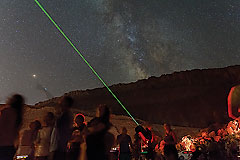The arches of Arches National Park are like windows to the universe, allowing us to take a glimpse into the past as well as consider what the future may bring. The National Park Service recognizes a naturally dark night sky as more than just a scenic canvas. It is part of a complex ecosystem that supports both natural and cultural resources. The opportunities to experience the natural environment are endless at Arches from the solitude of the backcountry, its rich soundscape, and of course dark night skies.
 Natural patterns of darkness are as important as the light of day to the functioning of ecosystems. Every creature on this planet has evolved in bright days, as well as dark nights. At least 30 percent of all vertebrates, and 60 percent of invertebrates are nocturnal with many of the rest being crepuscular. This means that the protection of naturally dark skies is essential for their survival, as well as ours. When we talk about light pollution, we talk about the health of ecosystems. However, no matter who we are or where we live, we live as part of one.
Natural patterns of darkness are as important as the light of day to the functioning of ecosystems. Every creature on this planet has evolved in bright days, as well as dark nights. At least 30 percent of all vertebrates, and 60 percent of invertebrates are nocturnal with many of the rest being crepuscular. This means that the protection of naturally dark skies is essential for their survival, as well as ours. When we talk about light pollution, we talk about the health of ecosystems. However, no matter who we are or where we live, we live as part of one.
The skies over southeastern Utah are profoundly dark, especially at Canyonlands and Arches national parks. In July, Arches was certified as an international dark sky park by the International Dark-Sky Association. The award was given in recognition of the park’s commitment to providing night sky outreach and preserving natural darkness in the park as well as in the surrounding communities. Arches is just one of a handful of internationally recognized parks, including Canyonlands National Park, Hovenweep National Monument, and Natural Bridges National Monument.
At the core of this achievement for Arches, is a number of dedicated employees, park partners, and community leaders that have led the charge in protecting the night sky. Their collaborative effort, over the course of the last five years, has made what once seemed impossible possible.
On Saturday, September 21, Arches will host a free nighttime event to celebrate their new international dark sky park status. Rangers from Arches and its neighboring parks will offer constellation tours and telescope viewings. Free shuttles will be provided. The local community and all members of the public are invited to take part in the festivities. For more details, visit Arches’ website calendar: www.nps.gov/arch/planyourvisit/calendar.htm
Moon Happenings
Sep 5 - First Quarter at 9:10 pm
Sep 13 - Full Moon at 10:32 pm
 Natural patterns of darkness are as important as the light of day to the functioning of ecosystems. Every creature on this planet has evolved in bright days, as well as dark nights. At least 30 percent of all vertebrates, and 60 percent of invertebrates are nocturnal with many of the rest being crepuscular. This means that the protection of naturally dark skies is essential for their survival, as well as ours. When we talk about light pollution, we talk about the health of ecosystems. However, no matter who we are or where we live, we live as part of one.
Natural patterns of darkness are as important as the light of day to the functioning of ecosystems. Every creature on this planet has evolved in bright days, as well as dark nights. At least 30 percent of all vertebrates, and 60 percent of invertebrates are nocturnal with many of the rest being crepuscular. This means that the protection of naturally dark skies is essential for their survival, as well as ours. When we talk about light pollution, we talk about the health of ecosystems. However, no matter who we are or where we live, we live as part of one. 